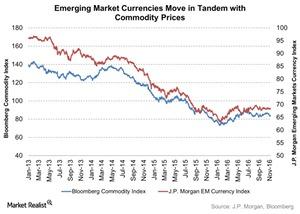Why Emerging Market Local Currency Bonds Are Looking Attractive
Emerging market economies have bounced back in 2016, delivering strong economic growth with improved fundamentals and better capital management.
Nov. 11 2016, Updated 1:04 p.m. ET

BUTCHER: Why might investors think of allocating specifically to local currency debt?
RODILOSSO: The number one case for investing in EM local currency debt is that average yields in that asset class are over 6%. Number two, many of EM central banks have scope to ease; not all, as some are in tightening mode. But rates overall have room to come in, both short rates and those farther out the curve. Regarding currency, currency risk can be a significant determination of your volatility and returns in the EM asset class. But EM currencies have underperformed for several years. Particularly as commodities got weaker, EM currencies were the negative part of the strong U.S. dollar trade. By contrast, EM currencies have recovered this year. The asset class has performed quite well in 2016 so far, but after the very tough years of 2013 to 2015. Many EM currencies have not gotten back nominally to where they were before, or when considered from the effective exchange-rate point of view. They tend to correlate fairly highly with commodities prices, and I think you have to be constructive, not wildly bullish, on commodity prices, to expect some currency gains.
Market Realist – Local currency EM debt looks promising
As discussed, local currency emerging market (or EM) bonds (EMB) (EMAG) (IGEM) provide better and higher yields than developed market bonds in the fixed income space. Emerging market economies have bounced back in 2016, delivering strong economic growth with improved fundamentals and better capital management after struggling with the strong dollar and falling commodity prices in 2015.
The local currency bond market also took a hit, but the performance of these bonds has improved. Investing in local currency sovereign debt not only rewards investors with high yields, it also provides them with additional exposure to currency appreciation.
The chart above shows that the EM market currency index represented by the J.P. Morgan EM Currency Index and the Bloomberg Commodity index move in the same direction. We’ve noted that EM currencies have been recovering in 2016. Most emerging markets derive a significant portion of their revenues from commodities.
Commodities bouncing back reflects better fundamentals for emerging markets. Higher commodity prices can help EM currencies to perform better, and vice versa. Higher commodity prices can lead to currency gains and ultimately better performances from emerging market bonds.
The chart above by VanEck shows that from 2003 to 2013, EM local currency sovereign bonds outperformed EM USD-denominated bonds by offering higher yields with improving credit quality. However, there’s no denying that these bonds also carry the usual risks of credit and currency risk.
In the next article, we’ll discuss the outlook for emerging market fundamentals.
